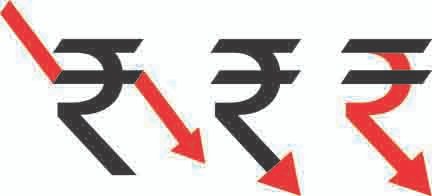The Indian currency has breached a crucial mark. Now, the dollar is worth more than `88. The reasons are obvious. The high US tariff on Indian goods will dent exports, which will imply lower foreign exchange earnings. The impact may be higher if punitive duties of 200 per cent are imposed on Indian drugs. Lower forex inflows will mean higher current account deficit (difference between export earnings and import expenses), which will depress the country’s foreign exchange reserves. These increase the pressures on the rupee.
There are huge outflows from the Indian stock markets. In August, the foreign institutional investors withdrew billions of dollars from Indian equities. According to media reports, they took out `35,000 crore last month, and the year-to-date selling was a massive `1.3 lakh crore, “raising concerns about India’s place in global portfolios, even as policy reforms and stronger-than-expected GDP data offer potential triggers for recovery.” Clearly, this dents the rupee’s value.
Equity allocations among the foreign investors are shifting to other emerging markets. Nomura reported that more than 70 per cent of emerging market funds are underweight on India, which is now the largest underweight market in such portfolios. The money has shifted to China, Hong Kong and Korea. Some experts feel that the trend is accentuated by the fact that Indian stocks are seen as being overvalued. Hence, there is selling and profit-booking, as the foreigners rotate the money to cheaper destinations.
If the US tariffs continue, or go up further, India will become a less-attractive destination for foreign direct investment. Although, foreign MNCs eye India for its large domestic market, they wish to make it a hub for global exports. If such firms wish to use the cheaper Indian manpower to ship products to the US, they will wait. There is no point setting up a plant in India, and not being able to export to the US. There is a fear that some of the existing foreign manufacturers may relocate their Indian plants to either the US, or other nations, which have lower tariffs. They may set up new plants there.
In the short run, experts are keenly watching the moves of the Reserve Bank of India (RBI). Although the central bank publicly states that it does not target a specific exchange rate against a specific foreign currency, it is known to aggressively step in to curb rupee volatility, and stabilise the currency. In this case, the RBI has allowed the rupee to slip beyond Rs 88. It may have some target in mind, or maybe there is a hope that a devalued currency will boost exports to other nations, except for the US. But then, it has an impact on imports, and may hamper the current account deficit.
A weaker rupee has domestic fallout. It may come in handy next year, and allow the RBI to generate huge surpluses, which will help it to hand out high dividends to the Government. This will help the Centre, which will face revenue pressures due to lower GST tax rates to be announced soon. The Govern- ment stares at extra expenditure due to its welfare schemes, and higher payouts as salaries and pensions to its employees due to the Eighth Pay Commission. The RBI dividends can help to keep the fiscal deficit in check.
One needs to factor in the future behaviour and mindset of the central bank. In the past, experts believed that the RBI would force the rupee to move in a narrow band, and step in to curb any downward movement. This gave businesses the confidence to reduce their hedges against currency fluctuations. Now, there seems to be a change, and the RBI is allowing the rupee to fall more than expected. If this is true, it may upset several corporate calculations, and result in huge forex losses, which will dent corporate profits.







